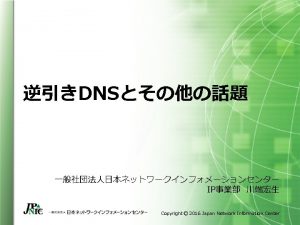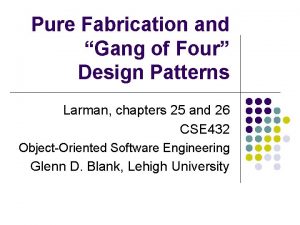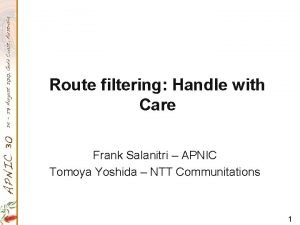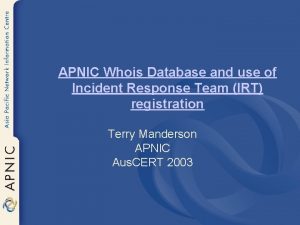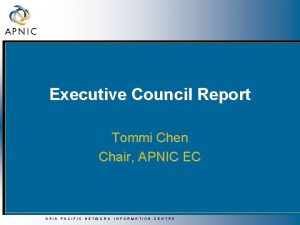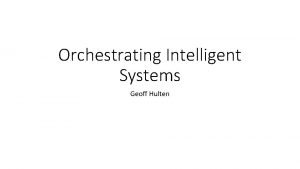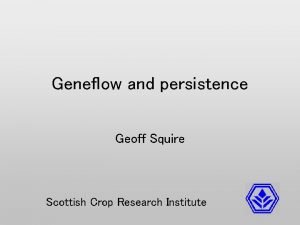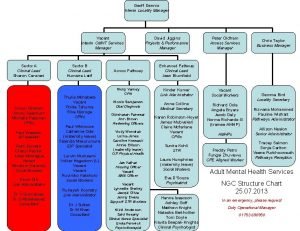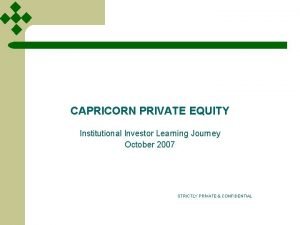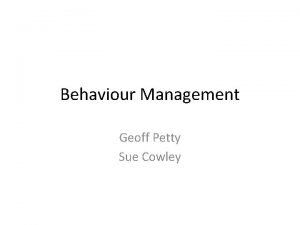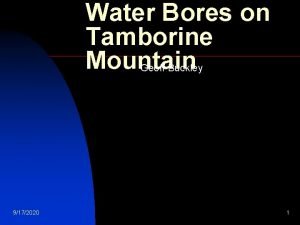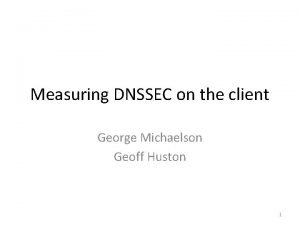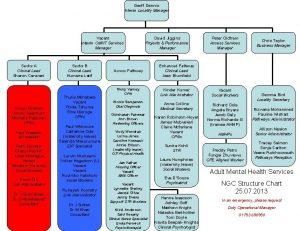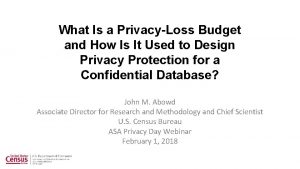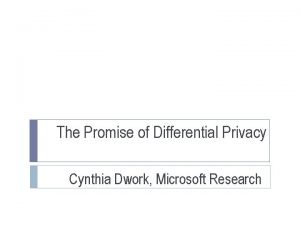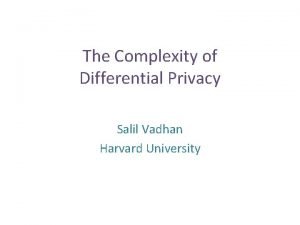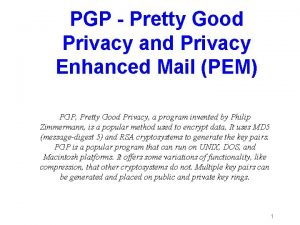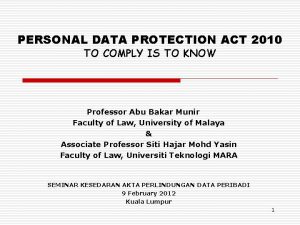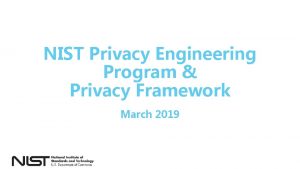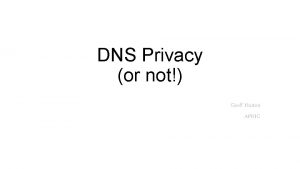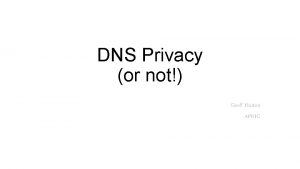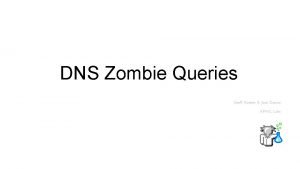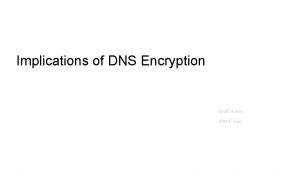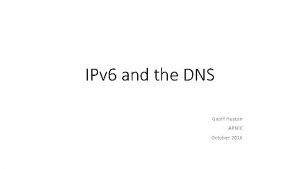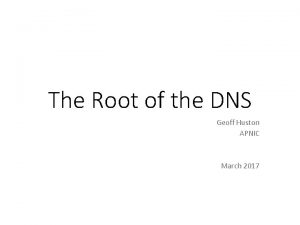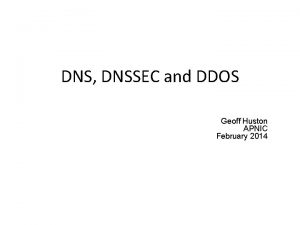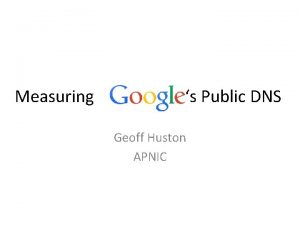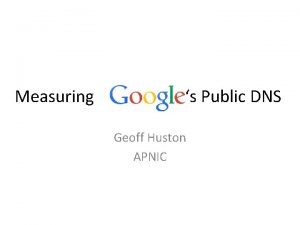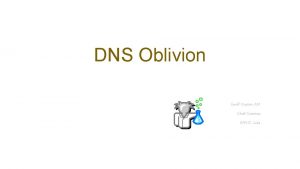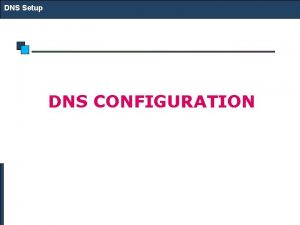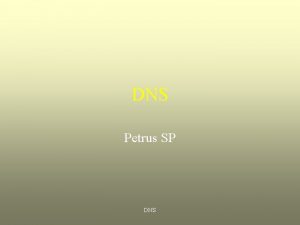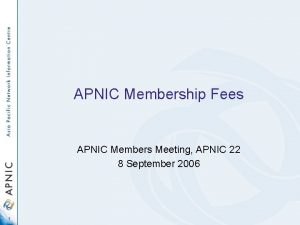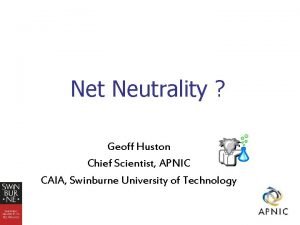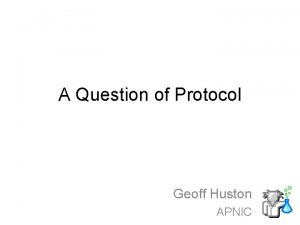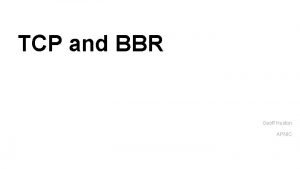DNS Privacy or not Geoff Huston APNIC https


















































- Slides: 50

DNS Privacy (or not!) Geoff Huston APNIC

https: //xkcd. com/1361/

Why? • Because everything you do on the net starts with a call to the DNS • If we could see your stream of queries in real time we could assemble a detailed profile of you and interests and activities • Do we have any evidence of DNS data mining? • Data miners don’t disclose their sources as a rule • How about something related: • Do we have any evidence of DNS stalking?

What if… • I gave you an absolutely unique name to resolve: • The name never existed before now • The name will never be used again • The name includes the time when the name was created • If I am the authoritative server for the name’s zone then I should see your efforts to resolve the name • Then I should never see the name as a resolution query ever again Unless you have attracted a digital stalker who performs re-queries of your DNS names!

What if DNS queries contained usable information? 06 s-0640 -uedb 11641 -c 13 -s 1565985257 -i 0 a 000001 -0. ap. dotnxdomain. net The querier is at 10. 0. 0. 1 The DNS label creation time is 1565985257 Querier is geolocated to Australia Then we could distinguish between the initial query and various re-query events!


DNS Re-query Rate • Over the past 30 days, some 5% of users have some kind of DNS stalker that is asking the same query more than 30 seconds after the initial query • Only some of these could be explained by incredibly slow DNS resolver systems Daily Counts Daily Ratios

DNS Stalking • There are two kinds of DNS stalkers • Rapid tracking stalkers that appear to track users in real time • Bulk replay stalkers that replay DNS queries at a very high rate in bursts

DNS Stalking by Query Age DNS Stalking uses both really recent data and more than year-old data! Real time stalking Log replay stalking

DNS Surveillance • The DNS appears to be used by many actors as a means of looking at what we do online and censoring what services we can access online

Top Stalker Subnets Rank 1 2 3 4 5 6 7 8 9 10 11 12 13 14 15 16 17 18 19 20 21 22 23 24 25 IP Net 119. 147. 146. 0 339, 855 101. 226. 33. 0 53, 181 180. 153. 206. 0 51, 592 112. 64. 235. 0 33, 067 180. 153. 214. 0 32, 954 101. 226. 66. 0 30, 863 180. 153. 163. 0 23, 941 180. 153. 201. 0 22, 673 101. 226. 89. 0 19, 337 221. 176. 4. 0 14, 019 101. 226. 65. 0 13, 604 101. 226. 51. 0 10, 226 112. 65. 193. 0 8, 619 66. 249. 93. 0 8, 306 180. 153. 205. 0 6, 816 180. 153. 114. 0 6, 796 69. 41. 14. 0 5, 724 66. 249. 81. 0 5, 218 66. 249. 88. 0 4, 817 66. 249. 80. 0 4, 685 222. 73. 77. 0 4, 471 180. 153. 161. 0 4, 352 180. 153. 211. 0 4, 271 66. 249. 85. 0 3, 774 93. 186. 23. 0 3, 707 Count AVG Delay AS Description 122. 6 4134 CHINANET-BACKBONE No. 31, Jin-rong Street, CN 1, 502. 2 4812 CHINANET-SH-AP China Telecom (Group), CN 1, 528. 0 4812 CHINANET-SH-AP China Telecom (Group), CN 1, 470. 8 17621 CNCGROUP-SH China Unicom Shanghai network, CN 1, 468. 4 4812 CHINANET-SH-AP China Telecom (Group), CN 1, 499. 3 4812 CHINANET-SH-AP China Telecom (Group), CN 1, 515. 0 4812 CHINANET-SH-AP China Telecom (Group), CN 1, 562. 2 4812 CHINANET-SH-AP China Telecom (Group), CN 1, 426. 4 4812 CHINANET-SH-AP China Telecom (Group), CN 855. 7 9808 CMNET-GD Guangdong Mobile Communication Co. Ltd. , CN 1, 519. 9 4812 CHINANET-SH-AP China Telecom (Group), CN 1, 490. 8 4812 CHINANET-SH-AP China Telecom (Group), CN 1, 555. 5 17621 CNCGROUP-SH China Unicom Shanghai network, CN 31, 355. 1 15169 GOOGLE - Google Inc. , US 1, 557. 0 4812 CHINANET-SH-AP China Telecom (Group), CN 1, 550. 6 4812 CHINANET-SH-AP China Telecom (Group), CN 810. 0 47018 CE-BGPAC - Covenant Eyes, Inc. , US 38, 095. 9 15169 GOOGLE - Google Inc. , US 31, 119. 7 15169 GOOGLE - Google Inc. , US 24, 641. 1 15169 GOOGLE - Google Inc. , US 1, 398. 5 4812 CHINANET-SH-AP China Telecom (Group), CN 1, 470. 3 4812 CHINANET-SH-AP China Telecom (Group), CN 1, 520. 9 4812 CHINANET-SH-AP China Telecom (Group), CN 23, 607. 7 15169 GOOGLE - Google Inc. , US 37. 3 18705 RIMBLACKBERRY - Research In Motion Limited, CA

Street Art: Banksy

Top 25 User Agent Strings of the stalked systems 6, 068 Mozilla/5. 0 (Windows NT 5. 1) Apple. Web. Kit/537. 36 (KHTML, like Gecko) Chrome/28. 0. 1500. 95 Safari/537. 36 SE 2. X Meta. Sr 1. 0 5, 458 Mozilla/5. 0 (Windows NT 6. 1; WOW 64) Apple. Web. Kit/537. 36 (KHTML, like Gecko) Chrome/28. 0. 1500. 95 Safari/537. 36 SE 2. X Meta. Sr 1. 0 5, 389 Mozilla/5. 0 (Windows NT 6. 1; WOW 64) Apple. Web. Kit/537. 36 (KHTML, like Gecko) Chrome/33. 0. 1750. 154 Safari/537. 36 5, 029 Mozilla/5. 0 (Windows NT 6. 1; WOW 64) Apple. Web. Kit/537. 36 (KHTML, like Gecko) Chrome/32. 0. 1700. 107 Safari/537. 36 4, 669 Mozilla/5. 0 (Windows NT 6. 1) Apple. Web. Kit/537. 36 (KHTML, like Gecko) Chrome/28. 0. 1500. 95 Safari/537. 36 SE 2. X Meta. Sr 1. 0 Sogou Explorer 2. X “It connects to the cloud to recognize malicious websites and software”

This data set is just a tiny glimpse into the overall pattern of web activity

DNS Surveillance • Can we stop DNS surveillance completely? • Probably not! • Can we make it harder to collect individual profiles of activity? • Well, yes • And that’s what I want to talk about today

The DNS Privacy Issue • Lots of actors get to see what I do in the DNS • • • My platform My ISP’s recursive resolver Their forwarding resolver, if they have one Authoritative Name servers Snoopers on the wire • Can we make it harder for these “others” to snoop on me?

How we might think the DNS works Client DNS Resolver DNS Server

What we suspect the DNS is like DNS Resolver Client DNS Resolver DNS Resolver DNS Server DNS Resolver DNS Resolver DNS Resolver

What we suspect the DNS is like Client DNS Resolver Corrupted host platforms Wireline and middleware Inspection and interception Resolvers that leak queries DNS Servers that leak queries DNS Resolver DNS Resolver DNS Resolver

Why pick on the DNS? • The DNS is very easy to tap • Its open and unencrypted • DNS traffic is easy to tamper with • Its payload is not secured and tampering cannot be detected • Its predictable and false answers can be readily inserted • The DNS is hard for users to trace • Noone knows exactly where their queries go • Noone can know precisely where their answers come from • The DNS is used by everyone

Second-hand DNS queries are a business opportunity these days

How can we improve DNS Privacy? • Lets look at a few behaviours of the DNS and see what we are doing to try and improve its privacy properties

1. The DNS is overly chatty The DNS uses the full query name to discover the identity of the name servers for the query name Hi root server, I want to resolve the A record for www. example. com Not me – try asking the servers for. com Hi. com server, I want to resolve the A record for www. example. com Not me – try asking the servers for example. com Hi example. com server, I want to resolve the A record for www. example. com Sure – its 93. 184. 216. 34

The DNS is overly chatty The DNS uses the full query name to discover the identity of the name servers for the query name Why are we telling root servers all our DNS secrets? In our example case, both a root server and a. com server now know that I am attempting to resolve the name www. example. com Maybe I don’t want them to know this

The DNS is overly chatty Is there an alternative approach to name server discovery that strips the query name in iterative search for a zone’s servers? Yes – the extra information was inserted into the query to make the protocol simpler and slightly more efficient in some cases But we can alter query behaviour to only expose as much as is necessary to the folk who need to know in order to answer the query

QNAME Minimisation • A resolver technique intended to improve DNS privacy where a DNS resolver no longer sends the entire original query name to the upstream name server • Described in RFC 7816

Example of QNAME Minimisation Ask the authoritative server for a zone for the NS records of the next zone: Hi Root server, I want to know the nameservers for com That’s a delegated zone, so here are the servers for. com Hi. com server, I want to know the nameservers for example. com That’s a delegated zone, so here are the servers for example. com Hi example. com server, I want to resolve the A record for www. example. com Sure – its 93. 184. 216. 34

Example of QNAME Minimisation r s e i r e qu heithe NS records of the next t Ask the authoritative server for a zonevefor a h s zone: user f o % 3 e m o know the nameservers for com Hi Root server, I want to s y l n zone, so here are the servers for. com o t That’s a delegated u y b a , d a o e t d i y Hi. comoserver, I want to know the nameservers for example. com a d w o s i g h t a aindelegated zone, so here are the servers for example. com It’s That’s d e t c e Hi example. com server, I want to resolve the A record for www. example. com t o r p Sure – its 93. 184. 216. 34

2. Interception and Rewriting • The DNS is an easy target for the imposition of control over access • Try asking for www. thepiratebay. org in Australia • Try asking for www. facebook. com in China Etc, etc • These days interception systems typically offer an incorrect response • How can you tell if the answer that the DNS gives you is the genuine answer or not?

DNSSEC • DNSSEC is defined in RFCs 4033, 4034 & 4035 • Adds a number of new RRtypes that allow a digital signature to be attached to RRsets in a zone and to define how keys that are used to generate signatures are also stored in the zone • DNSSEC validation of the DNS response can tell you if the response is genuine or if it is out of date or has been altered • DNSSEC can’t tell you what the “good” answer is, just that the answer you got was not it! • DNSSEC will also tell if is an NXDOMAIN response is authentic

DNSSEC and Recursive Resolvers • A DNS response that has been modified will fail to validate. When: • a client asks a security-aware resolver to resolve a name, and • sets the EDNS(0) DNSSEC OK bit, and • the zone is DNSSEC-signed then the recursive resolver will only return a RRset for the query if it can validate the response using the attached digital signature It will set the AD bit in the resolver response to indicate validation success Otherwise it will return SERVFAIL • But SERVFAIL is not the same as “I smell tampering” • Its ”nope, I failed. Try another resolver”

DNSSEC and Recursive Resolvers • If you are going to use a DNSSEC-validating recursive resolver • Such as 1. 1, 8. 8, 9. 9 or any other validating open resolver • Then make sure that all your resolvers perform DNSSEC validation if you don’t want to be mislead • Because SERVFAIL from a validating resolver means “try the next resolver in your resolver list”

DNSSEC in Mongolia

DNSSEC in Mongolia

3. Middleware and Wire. Tapping • Protecting the content of DNS responses is part of what we need to make the DNS more robust • If we want to prevent DNS inspection we also should look at encrypting the transport used by DNS queries and responses • Today the standard tool is TLS, which uses dynamically generated session keys to encrypt all traffic between two parties • We could use TLS between the end client and the client’s recursive resolver • It’s more challenging to use encryption between recursive resolvers and authoritative servers

DNS over TLS • TLS is a TCP ‘overlay’ that adds server authentication and session encryption to TCP • TLS uses an initial handshake to allow a client to: • Validate the identity of the server • Negotiate a session key to be used in all subsequent packets in the TCP session • RFC 7858, RFC 8310 TLS 1. 2 handshake

DNS over TLS • Similar to DNS over TCP: • Open a TLS session with a recursive resolver • Pass the DNS query using DNS wireline format • Wait for the response • Can use held DNS sessions to allow the TLS session to be used for multiple DNS queries • The queries and the responses are hidden from intermediaries • The client validates the recursive resolver’s identity

DNS over TLS and Android https: //android-developers. googleblog. com/2018/04/dns-over-tls-support-in-android-p. html

DNS over TLS • Will generate a higher recursive resolver memory load as each client may have a held state with one or more recursive resolvers • The TCP session state is on port 853 • DNS over TLS can be readily blocked by middleware • The privacy is relative, as the recursive resolver still knows all your DNS queries • Supported by Bind (stunnel), Unbound, DNSDist

DNS over QUIC • QUIC is a transport protocol originally developed by Google and passed over to the IETF for standardised profile development • QUIC uses a thin UDP shim and an encrypted payload • The payload is divided into a TCP-like transport header and a payload • The essential difference between DOT and DOQ is the deliberate hiding of the transport protocol from network middleware with the use of QUIC • No known implementations of DNS over QUIC exist, though IETF work continues draft-huitema-quic-dns-quic-06 DOT DOQ DNS TLS QUIC TCP UDP IP IP

Do. H - DNS over HTTPS • Uses an HTTPS session with a resolver • Similar to DNS over TLS, but with HTTP object semantics • Uses TCP port 443, so can be masked within other HTTPS traffic • Can use DNS wire format or JSON format DNS payload

Do. H - DNS within the Browser • Firefox’s “Trusted Recursive Resolver” • Avoids using the local DNS resolver library and local DNS infrastructure • Has the browser sending its DNS queries directly to a trusted resolver over HTTPS • Servers available from Cloudflare, Google, Clean. Browsing

Do. H - DNS within the Browser

5. EDNS(0) Client Subnet • There is a current debate between CDN operators that rely on customized DNS responses to perform content steering, and the use of large scale open resolvers that so not necessarily preserve locality • The result is that the CDN operators wanted the client’s subnet embedded in the query to ensure that the CDN could provide enhanced content steering for the client • This has raised a number of concerns about DNS privacy • There is a forming consensus that Client Subnet has been a step too far in terms of potential privacy leakage into the DNS

Hiding in the Crowd • What if you use an encrypted session to a very busy open resolver? • No third party can see you queries to the open resolver • Noone else can see the responses from the open resolver • The open resolver asks the authoritative servers which makes it challenging to map the query back to the end user • So if you are prepared to trust Goolge, Open DNS, Cloudflare, Quad 9 with your DNS then its far harder for anyone else to see you • But that is a very large amount of trust you are investing here!

Hiding in the crowd Internet Measurements Only 55% of the world’s users use their local ISP’s DNS service 39% of users use incountry DNS resolvers 20% of the world’s users use Google’s public DNS

Hiding in the crowd Mongolian Measurements 97% of the Mongolian users use their local ISP’s DNS service 51% of Mongolians list Google’s public DNS as a backup resolver

Choose your resolver carefully • The careful choice of an open recursive resolver and an encrypted DNS session will go a long way along the path of DNS privacy • But the compromise is that you are sharing your activity profile with the recursive resolver operator

My (current) DNS Config I use DNS over HTTPS • I have configured Cloudflare’s Cloudflared * to listen of localhost: 53 • I have set up my local /etc/resolv. conf to contain 127. 0. 0. 1 • All my DNS queries leave my laptop in an HTTPS port 443 stream towards 1. 1 * https: //developers. cloudflare. com/1. 1/dns-over-https/cloudflared-proxy/

Thanks!
 Geoff huston apnic
Geoff huston apnic Apnic dns
Apnic dns Cvs privacy awareness training answers
Cvs privacy awareness training answers Pure fabrication example
Pure fabrication example Langston huston
Langston huston Apnic debogon project
Apnic debogon project My.apnic
My.apnic Animal anthony apnic
Animal anthony apnic Apnic whois
Apnic whois Apnic ec
Apnic ec Not genuine not true not valid
Not genuine not true not valid Watchdog dad
Watchdog dad Icedip model of creative thinking
Icedip model of creative thinking Geoff hulten
Geoff hulten Geoff hollington
Geoff hollington Geoff squire
Geoff squire Geoff savage
Geoff savage Geoff wilson lexington ky
Geoff wilson lexington ky Lurvin munisami
Lurvin munisami Geoff baines
Geoff baines Conclusion of skin care
Conclusion of skin care Geoff parks
Geoff parks Geoff layer
Geoff layer Geoff snelgar net worth
Geoff snelgar net worth Geoff petty
Geoff petty Geoff hayward
Geoff hayward Geoff goldsmith
Geoff goldsmith Radiation safety
Radiation safety Cdmhp
Cdmhp Geoff knowles
Geoff knowles Geoff kleinman
Geoff kleinman Geoff mitchell md
Geoff mitchell md Geoff cundiff
Geoff cundiff Geoff buckley
Geoff buckley Sharon draper biography
Sharon draper biography Geoff michaelson
Geoff michaelson Geoff willis
Geoff willis Kavita deepak knights
Kavita deepak knights Geoff petty
Geoff petty Geoff barton dundee
Geoff barton dundee Geoff barton headteacher
Geoff barton headteacher Privacy loss budget
Privacy loss budget Army privacy office
Army privacy office Alexander v heise
Alexander v heise Cynthia dwork differential privacy
Cynthia dwork differential privacy Complexity of differential privacy
Complexity of differential privacy Dignity and privacy
Dignity and privacy What is a contingent contract
What is a contingent contract Privacy-enhanced mail
Privacy-enhanced mail Malaysia data privacy law
Malaysia data privacy law Privacy engineering framework
Privacy engineering framework

